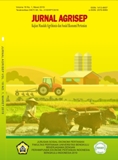Main Article Content
Abstract
Fruit in South Sumaterais mostlytropical fruit whichis relatively seasonal. However, the fruits in Palembangcityis available throughout the year. If it associated withthe levelofconsumption, availabilityoffruit does not directly guarantee that the community can fulfill all of its consumption.Therefore, the pattern of consumption of fruitvaries depending on consumption patterns based on household characteristics. This research aims to describe the consumption pattern of household fruits in Palembang City. The data used are cross section data, primary data is from food consumption expenditure modules for fruit groups household of the National Social Economic Survey in2017 Statistical officeof Palembang City. Data of783 householdsare used for the purpose of this research and analysed using is a descriptive method with tabulation.The results of the study revealed that fruit consensus patterns based on low and medium income groups were dominated by bananas (31.9% and 23%) and high groups of oranges(23.2%), then based on the number of household members consuming fruit in the number of members large and medium households are dominated by bananas (24.6% and 22.5%), and small households in oranges(22.4%). Based on the education level housewives withlow educationlevel mostly consumebananas (24.3%), moderate and high education levels of consumeoranges(23.3% and 22.9%respectively).So, it can be concluded that, the dominant fruit share based on the socio-economic characteristics is bananas.
Keywords
Article Details
Copyright (c) 2019 Tita Marsita

This work is licensed under a Creative Commons Attribution-ShareAlike 4.0 International License.
Authors who publish with this journal agree with the following terms:
- Authors retain copyright and grant the journal right of first publication with the work simultaneously licensed under a Creative Commons Attribution-ShareAlike 4.0 International License that allows others to share the work with an acknowledgment of the work's authorship and initial publication in this journal.
- Authors are able to enter into separate, additional contractual arrangements for the non-exclusive distribution of the journal's published version of the work (e.g., post it to an institutional repository or publish it in a book), with an acknowledgment of its initial publication in this journal.
- Authors are permitted and encouraged to post their work online (e.g., in institutional repositories or on their website) prior to and during the submission process, as it can lead to productive exchanges, as well as earlier and greater citation of published work (See The Effect of Open Access).
- This work is licensed under a Creative Commons Attribution-ShareAlike 4.0 International License.
References
- Assael, Henry. 2001. Consumer Behavior 6th Edition. New York: ThomsonLearning.
- Ariani M, Hardono GS. 2006. Pola Konsumsi Pangan Rumahtangga: Sebelum dan Pasca Krisis Ekonomi. Prosiding Seminar Nasional Pangan dan Gizi: Jakarta (ID).
- Atmarita. 2004. Analisis Situasi Gizi dan Kesehatan. WNPG VIII, LIPI. Jakarta, pp.147.
- BPS. 2016. pengeluaran untuk konsumsi penduduk Sumatera Selatan. Badan Pusat Statistik Provinsi Sumatera Selatan. Palembang
- BPS.2017. Statistik Buah-buahan dan Sayuran Tahunan Sumatera Selatan. Palembang. Badan Pusat Statistik Provinsi Sumatera Selatan.
- BPS. 2017. Susenas Konsumsi dan Pengeluaran Indonesia. Tahun 2017. Jakarta (ID): Badan Pusat Statistik.
- [FAO] Food and Agriculture Organization. 2014. Konsumsi Pangan. [Internet]. [diunduh 2015 Jun 17]. Tersedia pada: http://www. FAO.Org/konsumsipangan.
- Hartoyo, S. 1997. Analisis Permintaan Buah-buahan di Jawa Barat. Mimbar Sosek, Journal of Agricultural and Resource Socio-Economics. 10(1): 26-33.
- Kpodo F. M, Mensah C., dan Dzah C.S. 2015. Fruit and Vegetable Consumption Patterns and Preferences of Students in a Ghanaian Polytechnic. World Journal of Nutrition and Health 3(3):53-59.
- Kusrina, Rina. 2017. Permintaan Buah Utama Indonesia di Provinsi Jawa barat. Tesis Pascasarjana Institut Pertanian Bogor. Institut Pertanian Bogor. Bogor.
- Peter, J. Paul, dan Jerry C. Olson. 2014. Perilaku Konsumen & Strategi Pemasaran. Edisi 9 Buku 1. Jakarta: Salemba Empat
- Purwanto. 2010. Pengembangan Produktivitas dan Kualitas Manggis Indonesia[Tesis]. Bogor(ID): Institut Pertanian Bogor.
- Sawit M. 2014. Pengaruh Kredit dan bantuan Modal pada Perilaku Ekonomi dan Kesejahteraan Rumah tangga Tani di Provinsi Nusa Tenggara Timur [Disertasi]. Bogor (ID): Institut Pertanian Bogor.
- Sjarkowie dan Noerdin. 2015. Teori Kedaulatan Pangan. Balad Grafiti Pres. Palembang
- Wibawanti, 2009. Pengaruh Gaji Terhadap Motivasi Kerja Karyawan (Studi Kasus Pada Karyawan Home Industri Kripik Buah “Aisyah” Batu). Universitas Islam Negeri (UIN) Maulana Malik Ibrahim Malang.
References
Assael, Henry. 2001. Consumer Behavior 6th Edition. New York: ThomsonLearning.
Ariani M, Hardono GS. 2006. Pola Konsumsi Pangan Rumahtangga: Sebelum dan Pasca Krisis Ekonomi. Prosiding Seminar Nasional Pangan dan Gizi: Jakarta (ID).
Atmarita. 2004. Analisis Situasi Gizi dan Kesehatan. WNPG VIII, LIPI. Jakarta, pp.147.
BPS. 2016. pengeluaran untuk konsumsi penduduk Sumatera Selatan. Badan Pusat Statistik Provinsi Sumatera Selatan. Palembang
BPS.2017. Statistik Buah-buahan dan Sayuran Tahunan Sumatera Selatan. Palembang. Badan Pusat Statistik Provinsi Sumatera Selatan.
BPS. 2017. Susenas Konsumsi dan Pengeluaran Indonesia. Tahun 2017. Jakarta (ID): Badan Pusat Statistik.
[FAO] Food and Agriculture Organization. 2014. Konsumsi Pangan. [Internet]. [diunduh 2015 Jun 17]. Tersedia pada: http://www. FAO.Org/konsumsipangan.
Hartoyo, S. 1997. Analisis Permintaan Buah-buahan di Jawa Barat. Mimbar Sosek, Journal of Agricultural and Resource Socio-Economics. 10(1): 26-33.
Kpodo F. M, Mensah C., dan Dzah C.S. 2015. Fruit and Vegetable Consumption Patterns and Preferences of Students in a Ghanaian Polytechnic. World Journal of Nutrition and Health 3(3):53-59.
Kusrina, Rina. 2017. Permintaan Buah Utama Indonesia di Provinsi Jawa barat. Tesis Pascasarjana Institut Pertanian Bogor. Institut Pertanian Bogor. Bogor.
Peter, J. Paul, dan Jerry C. Olson. 2014. Perilaku Konsumen & Strategi Pemasaran. Edisi 9 Buku 1. Jakarta: Salemba Empat
Purwanto. 2010. Pengembangan Produktivitas dan Kualitas Manggis Indonesia[Tesis]. Bogor(ID): Institut Pertanian Bogor.
Sawit M. 2014. Pengaruh Kredit dan bantuan Modal pada Perilaku Ekonomi dan Kesejahteraan Rumah tangga Tani di Provinsi Nusa Tenggara Timur [Disertasi]. Bogor (ID): Institut Pertanian Bogor.
Sjarkowie dan Noerdin. 2015. Teori Kedaulatan Pangan. Balad Grafiti Pres. Palembang
Wibawanti, 2009. Pengaruh Gaji Terhadap Motivasi Kerja Karyawan (Studi Kasus Pada Karyawan Home Industri Kripik Buah “Aisyah” Batu). Universitas Islam Negeri (UIN) Maulana Malik Ibrahim Malang.
